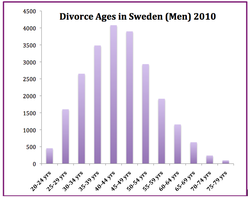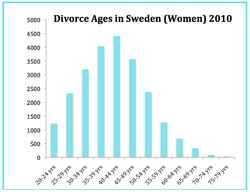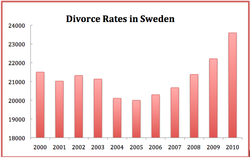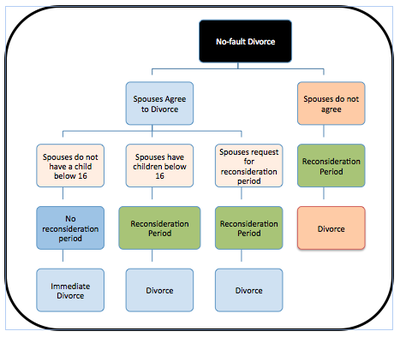- Divorce law in Sweden
-
 Divorce Law in Sweden
Divorce Law in SwedenLegal Marriage Code 1987
Chapter 5Parties Involved Heterosexual marriage couples
Same-sex marriage couplesRelated Statistics Crude DivorceRate '09: 2.4[1]
Mean Duration of Marriage to Divorce'08: 11.5yrs[2]
No. of Divorces '10: 23536[3]
No. of One Parent Families'10: 259754[4]
No. of Children with Female Single Parent'10: 78.5%[5]Divorce Age of Men in Sweden 2010[6] Divorce Age of Women in Sweden 2010[7] Divorce Rates Trend in Sweden 2000-2010 [8] Related Legislations and Policies Parents and Children Code 1949
Cohabitants Act 2003
Registered Partnership Act (1994:1117)
Private International Law
Foreign Laws
Property Law
Chapter 5: Divorce
Chapter 6: Maintenance
Chapter 7: The property of spouses
Chapter 14: Matrimonial cases and Maintenance casesDivorce and Family law Divorce law in Sweden concerns the dissolution of marriage, child support, alimony, custody and the division of property. Divorce restores the status of married people to individuals, leaving them free to remarry. The divorce laws in Sweden are known to be considerably liberal compared to other jurisdictions.
Contents
History of Divorce Laws In Sweden
The Swedish have in place a civil law system mostly dependent on statutory law. The German-Roman tradition of the European continental countries has influenced the development of Swedish law.[9] The first comprehensive Swedish Code, consisting of all its codified laws, came about in 1734, and is divided into the following Books:
- The Book of Marriage
- The Book of Parents
- The Book of Inheritance
- The Book of Land
- The Book of Building
- The Book of Commerce
- The Book of Crimes
- The Book of Judicial Procedure
- The Book of execution of Judgments
Law on Divorce In Sweden In The 17th Century
The law dating from the 17th Century only allowed two grounds for a divorce – adultery and desertion. These were generally in line with the Christianity beliefs and the principle of guilt[10] that influenced the Swedish. In the early 19th Century, simulated desertion was not unusual for couples who wanted to get divorced quickly.[11] One spouse would leave the country (as Copenhagen was the nearest foreign town, many went there) and the remaining spouse would file for divorce on grounds of desertion. The fact of desertion would be confirmed by the party who left the country.
Reform - The 1915 Act on the Celebration and Dissolution of Marriage
Towards the late 19th Century, three Scandinavian countries: Sweden, Norway and Denmark, wanted to cooperate in legislative reform.[12] The rationale was to provide equal treatment for Scandinavian citizens moving from one Scandinavian country to another.[13] In 1909, an Intergovernmental Committee was set up to prepare a common basis for reformation of family laws. The Committee was made up of delegates, experts and lawyers from the three countries.
In 1915, Sweden passed the Act on Celebration and Dissolution of Marriage. Under this Act, married couples could opt for a no-fault, mutual agreement to divorce. The divorce had to be based on ‘deep and permanent breakdown of the marriage’.[14] Often, a joint application by the spouses is indicative of the ‘breakdown of the marriage’.
The spouses were obliged to see a marriage counsellor before such an application was made. A judicial decree of separation would then be issued, requiring both spouses to be entirely apart for a year, before each party had the right to apply for divorce. The Act also allowed an immediate divorce in cases where one party was at fault. Such fault-based cases included chronic alcoholism, battering or contraction of a venereal disease.[15]
Under the reformed law on divorce, women enjoyed enhanced economic positions and equal authority in the household.
Further Reforms
In 1973, the law did not require mutual agreement between the spouses for a divorce. It was sufficient that one spouse wanted a divorce.[16] This made it even easier for spouses to get divorced. Only in certain cases was there a reconsideration period of six months. These were later transferred to the new Marriage Code (Chapter 5) in 1987 and still apply in Sweden today.[17]
Sources of Divorce Laws
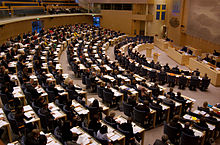 Sveriges riksdag - The Parliament of Sweden
Sveriges riksdag - The Parliament of Sweden
The Marriage Code
Divorce is governed by the Marriage Code of 1987.[18] Chapter 5 of the Code provides for the grounds of divorce. The laws regarding maintenance of spouses after divorce are set out in Chapter 6. Procedures for divorce come under Chapter 14. Other provisions regarding the custody of children and child maintenance are set out in the Children and Parents Code.
Other Sources of Divorce Law
Apart from the Marriage Code, preparatory legislative materials are also used as a source of law in Sweden. These materials include government bills and reports by the parliament’s committee.[19] For divorce in particular, the Bill on the revision of the old Marriage Code is one of the key preparatory materials used in interpreting divorce laws.[20]
Obtaining a Divorce
Divorce proceedings can be initiated by a joint application by the spouses, or by the application for a summons [21] by one of the spouses. Family counseling is encouraged but not compulsory.[22] If spouses agree to the divorce, no lawyers are needed. Any disputes arising will be resolved at the District Court.[23] In the main hearing, one legally qualified judge and three lay judges will preside.[24] At the end of the dispute, each party will normally be expected to bear his or her own legal costs.[25]
Applying for a divorce
Generally, an application of divorce involves submitting the population registration certificates of both parties, together with the payment of an application fee of 450 krona.[26] Additionally, a standard form must be completed and filed to the District Court where one of the partners is domiciled.[27] Domicile in this context means the place where one was registered for population purposes. Where neither of the partners is domiciled in Sweden, the application must be made to Stockholm City Court. Complications usually arise where spouses of different nationalities are involved. In such instances, there are special rules that will dictate when a Swedish court is competent to deal with the applications for divorce.[28]
When an application for divorce has been submitted, a notice from the District Court will be issued.[29] This notice will state the date on which the time for reconsideration begins, the earliest and latest dates on which the parties can proceed with the application and the case number given by the district court.[30]
Proceeding with the application means that the parties have confirmed their intention to divorce. To do so, party or parties to the divorce must notify the district court. This notice can be drafted on an ordinary sheet of paper. On the paper, the case number must be quoted and the spouse or spouses must expressly state that they still want a divorce. New personal identity certificate for both parties must then be submitted. If neither of the parties proceeds with the application within a year from the start of the time for reconsideration, the case will be removed from the district court lists and the parties then remain married to each other.[31][32]
Grounds for Divorce
Main article: Grounds for DivorceUnder marriage laws in Sweden, a divorce does not require any showing of fault or wrongdoing by either party as a ground for divorce. So long as the spouses agree to dissolve their marriage, they would be entitled to a divorce. This practice is commonly known as no-fault divorce.[33]
Reconsideration Periods
A legal separation period is not a preliminary requirement under Swedish law. However, both parties will go through a reconsideration period under two scenarios: firstly, if both parties request for a reconsideration period. Secondly, they have a child below the age of 16.[34]
If one spouse does not consent to the divorce, a reconsideration of 6 months will follow before the divorce.[35]
If the spouses have been living separately for two years, no reconsideration period is required and divorce can take place immediately.[36]
Under special circumstances where marriage was entered into despite the fact that the spouses are related to each other, no reconsideration period is required before a divorce. Similarly, in an event of bigamy, either party from the earlier marriage is entitled to an immediate divorce.[37]
Maintenance
There are two forms of maintenance - spouse maintenance and maintenance for children.
Maintenance for spouse
Main article: AlimonyThe fundamental idea is that divorce effectively severs all forms of economic relations between spouses.[38] Each spouse is therefore individually responsible for his or her own financial support after divorce. Maintenance is seldom granted except in certain circumstances. It must be shown that the spouse is financially needy and that the marriage has resulted in the need for maintenance.[39]
Maintenance is given when a spouse has difficulty in supporting himself or herself for a transitional period following the divorce. Such transitional maintenance provides the needy spouse with opportunities to seek gainful employment or retraining. The sum is determined by considering the spouse’s ability to pay, as well as several other factors.
Spousal maintenance is also granted in cases involving marriages of long duration where the spouse becomes financially needy following the separation. This form of maintenance extends over the transitional period and the exact duration is determined upon the relevant facts of each case.
Maintenance for children
Main article: Child SupportMaintenance for children is compulsory and the sum is to be determined either by an agreement or by a court decision.[40] When assessing the sum, consideration is given to the financial ability of the spouse paying. If the spouse does not pay anything or gives below the stipulated sum, child support is provided by the Swedish Social Insurance Agency.[41] The spouse is then required to reimburse the agency for all or part of the sums paid for towards the child.
Division of Assets
Main article: Division of propertyProperty owned by spouses in marriage can be labelled as either personal or marital property. Upon divorce, only marital property will be divided between spouses.[42]
 The ways in which property can be classified.[43]
The ways in which property can be classified.[43]
Treatment of marital assets
As marriage law in Sweden is driven by the principles of individuality and gender equality, a marriage is often viewed as a partnership. Thus, they are encouraged to settle their differences out of court by first negotiating and dividing their assets privately.
Upon negotiation, if the couple is in agreement:[44]
They are to send the division of marital property agreement (original and two copies containing the signatures of two witnesses) and population registration certificates (no older than three months) to the district court where they were registered.
If the couple is in disagreement:[45]
They can apply to the district court for the appointment of a marital property administrator, who will then make a decision regarding what should be included in the division of marital property, how items should be valued and how they should be divided. Generally, spouses are entitled to a 50-50 split of the property.[46] The courts will award the matrimonial home to the needier spouse, after subtracting the value from the amount the spouse was previously entitled to receive.[47]
If one of the spouses is not satisfied with the decision made by the administrator, he or she can appeal to the district court. The courts can override this equal-split rule if a 50-50 split will be unfair.[48] Some factors that may influence the court’s decision are the length of marriage and the economic standing of parties.Analysis and Assessment of Current Rules
Criticism of Swedish Divorce Law
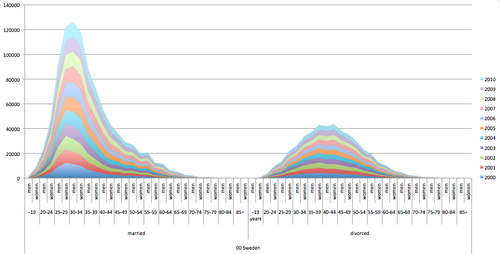 Divorce Statistics in Sweden 2010 [49]
Divorce Statistics in Sweden 2010 [49]
Critics have pointed towards the law as the reason for the increase in divorce rates in Sweden. Under the no-fault divorce law, parties can save on the time and money spent on legal procedures. There is no stigmatization from court investigations and no intrusion of the spouses’ private lives.[50] Critics see it as undermining the value of marriage, as couples plunge into marriage knowing their easy exit options should the marriage fail.
Critics also argue that the fact that no-fault divorces are unilateral, it takes away the control of the spouse who is trying to save the marriage.[51]
The legislation was also criticized for the grants given to the offspring of divorced parents.[52] In Sweden, almost 55% of the babies are born out of wedlock[53] and 46% of children are living with divorced parents.[54] The government however grants them equal care and protection as set out in the Children and Parents Code. If the parent is unable to pay the agreed allowance, the government steps in and pays them through Child Support Regimes.[55]
Opposition to European Union Divorce Proposal
The European Union has been facing strong opposition from Sweden to adopt the enhanced cross-border divorces laws across Europe. The proposal, known as Rome III,[56] will allow spouses of mixed nationality to choose which country’s divorce laws could govern their divorce.
Sweden’s resistance, however, is due largely to the fear that such a policy would violate the relatively liberal divorce laws in Sweden.[57] In 2006, the Swedish Ministry of Justice published a report warning against such blanket laws. It cited the possibility of European Courts having to apply restrictive divorce laws from non- European Union countries like Iran.
Swedish Civil Law vs Islamic Law Dichotomy
The Swedish Muslim Association, Sveriges muslimska förbund (SMF), has been demanding different sets of laws to be introduced for Muslims living in Sweden.[58] It is seeking for Muslims to be able to apply the Shariah in place of the Divorce and Family Law of Swedish legislation.
The Swedish government as well as other prominent muslims rejected the proposal as allowing Swedes to be subjected to the divorce laws of other countries is inconsistent with the Government’s intention of attaining racial equality treatment.[59]
Comparison across Countries
Grounds for divorce
One critical feature that marks Swedish divorce laws is the complete absence of any fault requirement when establishing a case for divorce. Fault is entirely irrelevant and has no legal consequences on the results of the proceedings.[60] Because there is no need to establish an irretrievable breakdown of marriage as the fundamental ground for divorce, the system remains virtually fault-free.
In addition, under the Swedish laws, there is no preliminary requirement of a separation period before a divorce case can be established.
In other jurisdictions such as United Kingdom [61] and Singapore,[62] divorce is purely granted on the basis of an irretrievable breakdown of marriage. The element of fault plays a significant role in establishing the presence of this breakdown. The spouse initiating the divorce is generally required to produce evidence of adultery, unreasonable behaviour or desertion within the marriage.
Apart from proving the element of fault as a ground for divorce, one can also rely on the presence of a separation period as evidence of an irretrievable breakdown of marriage. Thus, within these jurisdictions, the element of fault and the separation period are necessary in establishing the ground for divorce.
Mediation
Main article: MediationAnother area of distinction is that mediation in Sweden is on a purely voluntary basis.[63] Couples are not legally obliged to undergo mediation as part of the divorce procedure. In direct comparison, the UK legislation requires all couples to undergo a mandatory mediation assessment before they can proceed to court.[64] China's divorce laws also places a strong focus on mediation and courts are generally only utilized when mediation has failed.[65]
Pre-nuptial agreements
Main article: Prenuptial AgreementIn Sweden, agreements made before marriage are viewed as contracts and generally enforceable.[66] These agreements usually stipulate how assets are to be divided in case of a divorce.[67] Courts in other countries such as United Kingdom[68][69] and Singapore[70] adopt a more cautious approach towards the enforceability of pre-nuptial agreements. These agreements have been upheld in several recent cases but the law regarding pre-nuptial agreements in these countries is not settled as of now.
See also
- Divorce law around the world
- Judicial system of Sweden
- Sharia
- Enhanced co-operation
- Child support
- Child custody
- Child abduction
- Division of property
- Alimony
Appendix
International Divorce Rates and Divorce Laws[71][72][73][74][75] No. Country Divorce Rate (per 1000) Effective Waiting Period for No-fault Divorce Year When Divorce allowed Year No-fault Divorce allowed 1  Sweden
Sweden2.37 6 months (0 with consent) Pre 1950 Pre 1950 2  Italy
Italy0.60 3 years 1971 1975 3  Ireland
Ireland0.70 4 years 1997 1997 4  Greece
Greece0.90 4 years Pre 1950 1979 5  Spain
Spain0.94 1 year 1981 1981 6  Portugal
Portugal1.79 3 years (1 year with consent to divorce; 0 if a full agreement on all issues) 1977 1977 7  France
France1.98 6 years (0 with consent) Pre 1950 1976 8  Norway
Norway2.04 1 year Pre 1950 Pre 1950 9  Netherlands
Netherlands2.14 None Pre 1950 1971 10  Austria
Austria2.29 3 years (6 months with consent) Pre 1950 Pre 1950 11  Germany
Germany2.32 3 years (1 year with consent) Pre 1950 Pre 1950 12  Denmark
Denmark2.54 1 year (6 months with consent) Pre 1950 Pre 1950 13  Hungary
Hungary2.54 None Pre 1950 1971 14  Belgium
Belgium2.58 2 years (0 with consent) Pre 1950 Pre 1950 15  England
England2.65 5 years (2 years with consent) Pre 1950 1971 16  Scotland
Scotland2.66 5 years (2 years with consent) Pre 1950 1976 17  Finland
Finland2.72 6 months Pre 1950 Pre 1950 18  Switzerland
Switzerland2.72 4 years (0 with full consent and agreement) Pre 1950 Pre 1950 19  Russia
Russia3.65 None Pre 1950 1970 20  China
China0.79 2 years Pre 1950 1980 21  India
India1.10 6 months – 4 years (6 months with consent) Pre 1950 1954 22  Singapore
Singapore0.80 4 years (3 with consent) Pre 1950 1961 23  United States
United States5.20 0 to 18 months Pre 1950 1953 References
- ^ "Eurostat"
- ^ "OECD Family Database 2011"
- ^ "United Nations Economic Commission for Europe Statistics"
- ^ "United Nations Economic Commission for Europe Statistics"
- ^ "United Nations Economic Commission for Europe Statistics"
- ^ "Sweden Statistics"
- ^ "Sweden Statistics"
- ^ “EuroStat Divorce Indicators”
- ^ "Ingrid Kabir, Swedish Law on the Internet"
- ^ Nathalie Le Bouteillec, Zara Bersbo and Patrick Festy, Freedom to Divorce or Protection of Marriage? The Divorce Laws in Denmark, Norway, and Sweden in the Early Twentieth Century, Journal of Family History 36(2) 191-209
- ^ Ibid
- ^ Per Simonsson and Glenn Sandstorm, Ready, Willing, and Able to Divorce: An Economic and Cultural History of Divorce in Twentieth-Century Sweden, Journal of Family History 36(2) 210-229
- ^ Ibid
- ^ Maarit Jänterä-Jareborg, "Grounds for Divorce and Maintenance Between Former Spouses", (2002)
- ^ Supra n 5
- ^ Supra n 7
- ^ Ibid
- ^ Supra n 7
- ^ "Ingrid Kabir, Swedish Law on the Internet"
- ^ Supra n 7
- ^ "Swedish Courts, Legal proceedings for divorce"
- ^ "Swedish Courts, Family counseling"
- ^ "Swedish Courts, Application for divorce"
- ^ "Swedish Courts, Hearing in the District Courts"
- ^ Ibid
- ^ Supra n 16
- ^ Ibid
- ^ Ibid
- ^ Ibid
- ^ Ibid
- ^ Ibid
- ^ The Marriage Code (Äktenskapsbalken) Chapter 5 Section 3; SFS 1987:230, with subsequent amendments up to and including SFS 2000:1731
- ^ Supra n 7
- ^ "Swedish Courts, Divorce"
- ^ The Marriage Code (Äktenskapsbalken) Chapter 5 Section 2; SFS 1987:230, with subsequent amendments up to and including SFS 2000:1731
- ^ The Marriage Code (Äktenskapsbalken) Chapter 5 Section 4; SFS 1987:230, with subsequent amendments up to and including SFS 2000:1731
- ^ The Marriage Code (Äktenskapsbalken) Chapter 5 Section 5; SFS 1987:230, with subsequent amendments up to and including SFS 2000:1731
- ^ Supra n 7
- ^ Ibid
- ^ "Manches LLP, Sweden Divorce Fact Sheet "
- ^ "Ministry of Justice, Parents and Children - Brief Information about Current Legislation"
- ^ D. Bradley, Marriage, Family, Property and Inheritance in Swedish Law, The International and Comparative Law Quarterly, Vol. 39, No. 2 (Apr., 1990), pp375
- ^ "Family Law:Information on the Rules"
- ^ "Division of Marital Partnership Property"
- ^ Ibid
- ^ D. Bradley, Marriage, Family, Property and Inheritance in Swedish Law, The International and Comparative Law Quarterly, Vol. 39, No. 2 (Apr., 1990), pp375
- ^ The Marriage Code (Äktenskapsbalken) Chapter 11 Section 8; SFS 1987:230, with subsequent amendments up to and including SFS 2000:1731
- ^ Jacob W. F. Sundberg, Recent Changes in Swedish Family Law: Experiment Repeated, The American Journal of Comparative Law, Vol. 23, No. 1 (Winter 1975), pp35
- ^ "Sweden Statistics: Belforkningsstatistik 2009"
- ^ "The Daily Mail: Keep Warring Couple Out Of Court With No Fault Marriage Break-Up Say Divorce Reformers"
- ^ "No Fault Marriage Pros and Cons"
- ^ Bernard G. Weiss, In Sweden, Divorce is Kind. San Francisco Chronicle, 1985, pg. 25.
- ^ "New York Times: Out-of-Wedlock Birthrates Are Soaring, U.S Reports"
- ^ Kiernan, K 2002, “Unmarried Cohabitation And Parenthood: Here to stay? European Perspectives”, Conference on Public Policy And The Future Of Family, London School of Economics, London, pp. 10.
- ^ "Government Office of Sweden: Needs Allowance"
- ^ [Peers, S 2010, "Divorce, European Style: The first Authorization of Enhanced Corporation",European Constitutional Law Review, no.6,p.339.]
- ^ "Stockholm News"
- ^ "The Brussels Journal: Swedish Muslims Want Separate Laws"
- ^ "The Salt Lake City Newspaper: Law Request Is Rejected By Swedes And Muslims"
- ^ Supra n 7
- ^ "Terry & Co Solicitors, Divorce in England - UK Divorce Law"
- ^ Women's Charter (Cap 353, 2002 Rev Ed) s95
- ^ Supra n 7
- ^ "BBC News: Divorce: Mediation should help married couples split up"
- ^ Catherine R. Chyi, Lessons from China?: Keeping Divorce Rates Low in the Modern Era,23 Pac. McGeorge Global Bus. & Dev. L.J. 285
- ^ "McGuire Woods, Legal Updates - UK Tax & Private Client: Prenuptial Agreements Move into the Future"
- ^ "Catherine Fairbairn,Pre-nuptial agreements: recent developments
- ^ "Law Commission Report: A study of the views and approaches of family practitioners concerning marital property agreements"
- ^ Supra n 39
- ^ Debbie Ong S. L., Prenuptial agreements and Formal Matrimonial Agreements: TQ V TR, (2007) 19 SAcLJ 397
- ^ Gonzalez, L. V,Tarja 2006, 'The Effect of Divorce Laws on Divorce Rates in Europe', IZA Discussion Paper No. 2023
- ^ "Department of Statistics Singapore: Marriages and Divorce 2010"
- ^ "The Indian Divorce Act 1869"
- ^ "National Vital Statistics Report"
- ^ "History of Divorce Around The World"
External links
- Swedish Legislation: Grounds For Marriage and Divorce
- FAQ on Swedish Legislation: Grounds For Marriage and Divorce
- The Swedish District Courts
- Swedish Legislation: Children and Parents Code
- Government Offices of Sweden: Children's Rights
- International Family Law Resources
- Sweden Marriage and Divorce Law Advice
- Guide to Swedish Law Systems
- Guide to Sweden Law Online
- Britain Pushes To Follow Sweden's Liberal Divorce Laws
- Forum on Sweden Divorce: The Locals, Sweden's Local News In English
- Britian's High Courts View on Separate Islamic Law
- France Does Not Recognise Islamic Divorce
- Ohio Does Not Recognise Islamic Divorce
Categories:- Divorce
- Swedish law
Wikimedia Foundation. 2010.
Look at other dictionaries:
Divorce law around the world — This article is a general overview of divorce laws around the world. Every nation in the world except the Philippines and the Vatican City allow some form of divorce. Contents 1 Muslim societies 2 Argentina 3 Brazil … Wikipedia
Law and divorce around the world — This article is a general overview of divorce laws around the world. Every nation except Malta,the Philippines and the Vatican City allows legal divorce. [ [http://www.reuters.com/article/worldNews/idUSMAN22419320070213 Filipinos celebrate… … Wikipedia
Sweden — • The largest of the three Scandinavian countries and the eastern half of the Scandinavian peninsula Catholic Encyclopedia. Kevin Knight. 2006. Sweden Sweden … Catholic encyclopedia
Law — /law/, n. 1. Andrew Bonar /bon euhr/, 1858 1923, English statesman, born in Canada: prime minister 1922 23. 2. John, 1671 1729, Scottish financier. 3. William, 1686 1761, English clergyman and devotional writer. * * * I Discipline and profession… … Universalium
law — W1S1 [lo: US lo:] n ▬▬▬▬▬▬▬ 1¦(system of rules)¦ 2¦(a rule)¦ 3 law and order 4¦(police)¦ 5¦(what always happens)¦ 6¦(study/profession)¦ 7¦(sport/activity)¦ 8 the law of the jungle 9 the law of averages 10 be a … Dictionary of contemporary English
Divorce demography — The current marriage to current divorce ratio measures the divorce rate by comparing the number of marriages to the number of divorces in a given year.[1] For example, if there are 500 divorces and 1,000 marriages in a given year in a given area … Wikipedia
Divorce of same-sex couples — Legal recognition of same sex relationships Marriage Argentina Belgium Canada Iceland Netherlands Norway Portugal South Africa Spain Sweden … Wikipedia
law — law1 lawlike, adj. /law/, n. 1. the principles and regulations established in a community by some authority and applicable to its people, whether in the form of legislation or of custom and policies recognized and enforced by judicial decision. 2 … Universalium
Law of Jersey — The Law of Jersey has been influenced by several different legal traditions, in particular Norman customary law, English common law and modern French civil law.[1] The Bailiwick of Jersey is a separate jurisdiction from that of the United Kingdom … Wikipedia
No-fault divorce — Family law Entering into marriag … Wikipedia
18+© Academic, 2000-2025- Contact us: Technical Support, Advertising
Dictionaries export, created on PHP, Joomla, Drupal, WordPress, MODx.Share the article and excerpts
Divorce law in Sweden
- Divorce law in Sweden
-
 Divorce Law in Sweden
Divorce Law in SwedenLegal Marriage Code 1987
Chapter 5Parties Involved Heterosexual marriage couples
Same-sex marriage couplesRelated Statistics Crude DivorceRate '09: 2.4[1]
Mean Duration of Marriage to Divorce'08: 11.5yrs[2]
No. of Divorces '10: 23536[3]
No. of One Parent Families'10: 259754[4]
No. of Children with Female Single Parent'10: 78.5%[5]Divorce Age of Men in Sweden 2010[6] Divorce Age of Women in Sweden 2010[7] Divorce Rates Trend in Sweden 2000-2010 [8] Related Legislations and Policies Parents and Children Code 1949
Cohabitants Act 2003
Registered Partnership Act (1994:1117)
Private International Law
Foreign Laws
Property Law
Chapter 5: Divorce
Chapter 6: Maintenance
Chapter 7: The property of spouses
Chapter 14: Matrimonial cases and Maintenance cases

